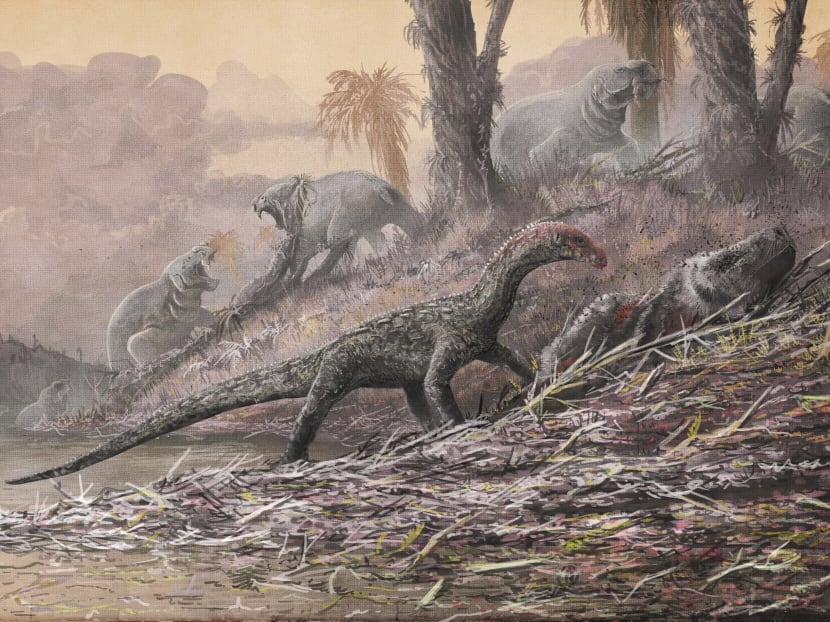A dinosaur cousin’s crocodile ankles surprises paleontologists
NEW YORK — Paleontologists excavating a basin in southern Tanzania have uncovered 245-million-year-old fossils belonging to one of the earliest relatives of dinosaurs. The carnivorous creature, which is not a direct ancestor to dinosaurs but more of a close cousin, is called Teleocrater rhadinus. The discovery, which was reported Wednesday in Nature, may help scientists fill in gaps in our understanding of how dinosaurs evolved as well as provide insight into what their earliest relatives looked like.

This artist's rendering provided by Mark Witton in April 2017 shows a Teleocrater rhadinus, center, a four-legged, meat-eating reptile and a close relative of dinosaurs, eating a relative of mammals, Cynognathus. The large dicynodont Dolichuranus is seen in the background. Illustration: Natural History Museum, London via AP
NEW YORK — Paleontologists excavating a basin in southern Tanzania have uncovered 245-million-year-old fossils belonging to one of the earliest relatives of dinosaurs. The carnivorous creature, which is not a direct ancestor to dinosaurs but more of a close cousin, is called Teleocrater rhadinus. The discovery, which was reported Wednesday in Nature, may help scientists fill in gaps in our understanding of how dinosaurs evolved as well as provide insight into what their earliest relatives looked like.
“For the first time we have a good idea of what the very first forms on the lineage leading to pterosaurs, dinosaurs and birds looked like,” Dr Randall B Irmis, a curator of paleontology at the Natural History Museum of Utah who was not involved in the study, said in an email about the study. “I think this will spark a lot of research into how and why pterosaurs and dinosaurs evolved into such different forms from their early relatives.”
The Teleocrater is an archosaur, a group that includes all birds, dinosaurs and the flying reptiles pterosaurs, as well as crocodiles and alligators. About 250 million years ago, at the beginning of the Triassic Period, the archosaurs broke into two main branches: The bird bunch, which includes dinosaurs, and the crocodile crew. Teleocrater is considered an early member of the bird-line archosaurs, appearing some 10 million to 15 million years before dinosaurs entered the lineage.
But for a creature so closely related to dinosaurs, it did not look very dinosaurlike. It was between 6 and 10 feet (1.8 and 3m) long and resembled a Komodo dragon with an elongated neck. It also walked on four limbs.
What paleontologists found most surprising about the creature were the bones in its ankles, which were more similar to those found in crocodiles than those found in dinosaurs and birds — even though Teleocrater was on team bird and not team croc. The unexpected finding suggests that features previously thought to have evolved in one branch may have existed in a common ancestor of both groups.
“This is along the lines of rewriting our understanding of the very earliest history of the bird and dinosaur lineage,” said Dr Kenneth Angielczyk, a paleobiologist at the Field Museum in Chicago and an author on the study. “It changes our understanding of what that first step in the evolution of dinosaurs was like.”
The first Teleocrater remains to be discovered were found in the 1930s by Francis Rex Parrington, a famous paleontologist from Cambridge University. Unsure of what he had collected, he stored the bones away until they were uncovered by his graduate student Alan Charig in the 1950s. He identified it as an archosaur and named it Teleocrater, but the designation was never made official, nor was the creature ever placed on the dinosaur family tree.
It wasn’t until 2015 that Angielczyk, Sterling J. Nesbitt, a paleontologist from Virginia Tech, and their colleagues uncovered an unusual set of bones in Tanzania that proved Charig was right.
“It seemed like a fairly strange animal,” Dr Angielczyk said, “but it wasn’t until we got it back to the lab and got it cleaned that the full implications of its relationship to birds and dinosaurs became apparent.”
The team, which includes researchers from the United States, England, Argentina, South Africa, Sweden and Russia, identified several features, like a depression in its skull, that further showed the Teleocrater was an archosaur from the bird lineage. But by also finding that it had a crocodile-like ankle, the team connected the dinosaur and bird branch to the crocodile branch in a way that was not previously known.
Dr Kevin Padian, an integrative biologist at the University of California, Berkeley, who reviewed the paper, said the findings showed that the features that have traditionally been associated with the bird-dinosaur line did not evolve in lockstep.
“The bottom line is that we have so much new information that we’re seeing a far more complex picture than we had 30 years ago,” he said, “and that’s an important evolutionary insight.” THE NEW YORK TIMES





